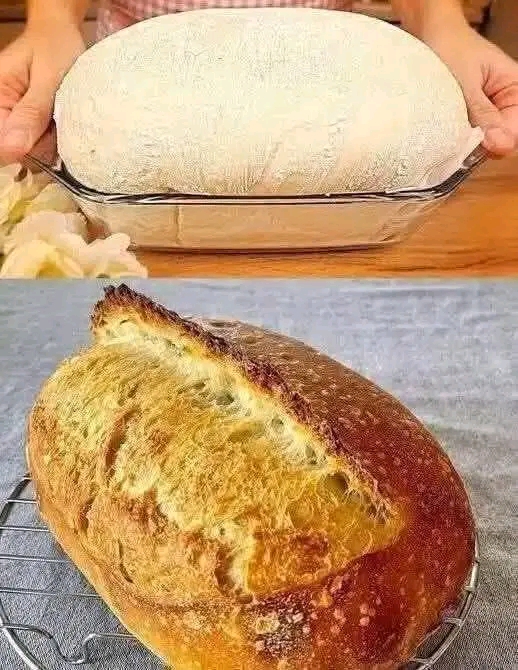best easy bread recipe cheap homemade bread no knead bread recipe simple budget‑friendly loaf homemade soft loaf no eggs no butter vegan friendly bread loaf recipe
I don’t buy bread anymore! No kneading, No eggs, No butter! The easiest and cheapest bread recipe
If you’ve been spending too much on store‑bought loaves that disappear in days and often contain hidden preservatives or additives, you’re about to discover how incredibly easy and affordable homemade bread can be. This simple, no‑knead bread recipe uses everyday pantry staples—flour, water, yeast, salt, sugar, and a splash of oil—to yield a soft, hearty loaf that’s perfect for sandwiches, toast, or dipping. It’s beginner‑friendly, budget‑friendly, and totally satisfying—the kind of homemade bread that’ll make you wonder why you ever bought it from a store. Let’s dive into this easy bread recipe that’s truly a game‑changer.
introduction
Imagine slicing into warm, fresh homemade bread with a golden crust and soft crumb — without kneading, without eggs, without butter. This recipe is a straightforward no‑knead bread method that combines simple pantry ingredients and time to work its magic. You’ll mix, wait, bake—no complicated steps, no special tools needed, just a beautiful loaf of bread made at home for pennies. In this article, we’ll walk through why this recipe works so well, how to make it step‑by‑step, tips for success, variations, serving ideas, and even why your family will keep asking for more.
why this recipe works
This easy bread recipe is budget‑friendly and minimalist, using only indispensable kitchen staples. Recipes like this one—featuring flour, water, yeast, salt, sugar, and oil—are bread‑baking at its simplest and most accessible . The “no knead” approach relies on fermentation over time to develop gluten structure naturally, meaning you can get a nice texture with minimal effort . The lack of eggs or butter cuts out expensive or perishable ingredients, making the loaf economical and suitable for diets that avoid dairy or animal products .
ingredients you’ll need
• 300 g (about 2 cups) bread flour or wheat flour (all‑purpose works too)
• 200 ml (about ¾ cup plus 1 tbsp) lukewarm water, to activate yeast and hydrate dough
• 25 g (2 tbsp) sugar (feeds yeast, adds slight sweetness)
• 3 g (1 tsp) active dry or instant yeast
• 3 g (½ tsp) salt (enhances flavor, strengthens gluten)
• 20 g (2 tbsp) olive oil (adds moisture, softens crumb—no butter needed)
step‑by‑step method
- In a mixing bowl, combine the lukewarm water and sugar; stir until dissolved. Sprinkle the yeast on top and let it sit for 5–10 minutes until frothy, proving the yeast is active .
- Add flour and salt to the yeast mixture and stir until everything starts to come together.
- Pour in the olive oil and continue mixing until well incorporated. The dough will look shaggy and slightly sticky—that’s perfect; it means no kneading is needed .
first rise
Cover the bowl with a clean kitchen towel or plastic wrap and place in a warm, draft‑free spot. Let the dough rise for 1–2 hours or until doubled in size .
shape and second rise
Gently deflate the dough and transfer to a lightly floured surface. Shape into a round or oval loaf—or divide into rolls if preferred. Place it on a parchment‑lined baking tray or into a greased loaf pan. Cover and let it rest another 20–30 minutes while you preheat your oven to 375 °F (190 °C) .
bake
Bake for 20–25 minutes—until the crust is golden and the loaf sounds hollow when tapped . For a crispier crust, tent with foil partway through baking or place the loaf directly on a preheated baking stone if available.
cool before slicing
Let the bread cool on a wire rack for at least 10 minutes (preferably longer) before slicing. This resting time helps the interior set and ensures perfect texture .
tips for baking success
• Lukewarm water should be around 100–110 °F (37–43 °C)—not hot, not cold—to activate yeast without killing it .
• Use fresh yeast; if not sure, test by proofing in warm water with sugar.
• For a chewier texture, use bread flour; to make it more wholesome, substitute part of the flour with whole wheat.
• Add herbs, garlic, or seeds to the dough for an extra flavor boost .
• Store the loaf in a bread box or loosely wrapped at room temperature for 2–3 days, or freeze sliced bread for longer storage .
variations you might love
• Japanese milk‑style twist: Replace half of the water with warm milk (or plant‑based milk) plus 1 tbsp of oil to yield an ultra‑soft, slightly sweet loaf—still no knead, no eggs, no butter .
• Preference for rustic artisan? Let the dough ferment overnight (12–18 hours) and bake in a preheated Dutch oven at 450 °F (230 °C) for a crustier exterior and more complex flavor .
• Soda bread alternative: If you’re out of yeast, try a quick soda bread—mix milk (or buttermilk), vinegar (or lemon juice), flour, baking soda, and salt; bake immediately for fast, yeast‑free bread .
serving suggestions
This versatile loaf pairs beautifully with butter, jam, honey, or avocado for breakfast. Use it to build sandwiches, garlic toast, or hearty croutons. It also complements soups and stews when dipped into brothy bowls for cozy meals.
why you’ll keep coming back
Because this recipe makes homemade bread feel effortless, affordable, and utterly satisfying. The sense of accomplishment when slicing into your own loaf is unmatched—plus the aroma of fresh bread filling your kitchen is pure joy. It’s flexible enough to experiment with flavors, textures, and methods. Once you’ve made it once, you’ll see bread baking as your new favorite superpower.
closing note
Thank you so much for reading! If you loved this no‑knead, no‑eggs, no‑butter bread recipe, I can’t wait to share more delicious, effortless creations with you. Keep coming back for kitchen magic that’s budget‑friendly, kid‑approved, and heartwarming. Your support means the world—happy baking and talk soon!

